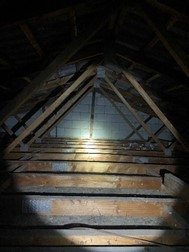Building Basics – Insulation
When we conduct a thorough property inspection, one of the building basics we are looking for is insulation. We’re looking for whether your potential new home has it, and if so, what type it is – and how it’s likely to be performing.
Good insulation acts like a blanket to keep your home warm in winter and cooler in summer. But if it’s not up to scratch, or non-existent, you’ll soon find out with chilly floors, cold rooms and often, condensation, mould, and damp issues. An uninsulated or barely insulated house will also suffer from poor thermal performance, with heating costs and power bills soaring as a result. So, it’s important for any property inspection to include this in the report.
Age of the home and types of insulation
The main types of insulation on the market today are polystyrene, glass wool and polyester. Each has a different R value, which is a measure of the insulation’s effectiveness. The higher the R value, the better the insulation will perform.
The age of the property will often determine what sort of insulation – if any – we find. Houses built before 1978 are unlikely to have any insulation, unless it has been added later, and houses built before 2007 have lower than the currently-required levels of insulation, and often only single glazing as well. The upshot is that, unfortunately, many Kiwis are occupying homes that don’t meet current insulation standards.
Where do we look and what are we looking for?
Where there is access, we will be looking in the roof cavity and subfloor.
Roof cavity
In the ceiling, or roof cavity, we’ll be checking out what’s up there and if it’s in good condition. Ceiling insulation can be in blankets that cover joists, in segments (like Pink Batts) fitted between them, or it can be blown in as loose fill. The type of insulation used will give us an indicator of when it’s been installed: newer fibreglass or earth wools are thicker and have higher R values. Sometimes we come across older type blown type insulation, this type can contain asbestos, so that’s certainly something to flag in the report.
We’ll be looking at how well the insulation is laid, and if there are any gaps. For example, insulation can drift over time, particularly if you’ve had workers or tradies up there moving it aside to access wires or joists.
Another thing to check is whether any downlights in the ceiling are rated for insulation, as safety requirements call for a gap between older-style downlights and insulation. Loose fill insulation, i.e., not in ‘sheets’, can spill onto the top of the downlight and cause a serious fire hazard that we reckon you’d also want to avoid.

Property built approx. early 1970s, no ceiling insulation

Older type blown insulation – may contain asbestos

Insulation on a new build property moved by trades and not correctly reinstated
Subfloor
In the sub floor, we’ll be looking to see that any insulation has been installed correctly. It’s usually in the form of polyester, polystyrene blocks, or glass wool, which is fitted between the joists, stapled, or strapped in place. We might occasionally come across foil underfloor insulation, which was banned in 2016 after workers were electrocuted while installing it. A recent house we inspected had sarking type insulation which was foil that went over the bottom of the joists. When it was pushed up from underneath, you could feel the water (from an internal wet area leak) sitting in the insulation like a hammock. This is worse for any surrounding timber as the water will soak in and cause more damage in a shorter period of time.

Leaking water

Uninsulated subfloor – underside of flooring visible
Walls
It’s harder to work out what kind of insulation is in the walls, but it all comes back to the age of the house and the Building Code. Existing walls can be retrofitted with a type of foam or polystyrene bead insulation that’s blown into the top of the wall cavity, or through an external wall. A tell-tale sign is the holes made in the external cladding.
It’s important to note that retrofitting wall insulation to external walls may require a building consent. Your property inspector will not be able to check if a building consent has been granted, but we can advise you if this insulation appears to have been done.
When it comes to insulation, it’s important to know what you do or don’t have. With the diversity of NZ’s housing stock, it can be a real lottery. High quality insulation that’s installed well makes a huge difference to the wellbeing of any home’s occupants. And in the long run it saves money on heating and cooling bills.
Make sure you get expert information and advice right from the start with a comprehensive report from your friendly Property Inspector.







